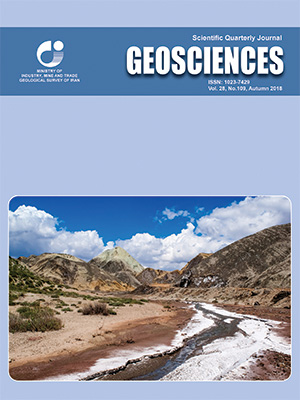Choi, W., Galasinski, U., Cho, S. and Hwang, C., 2012- A spatiotemporal analysis of groundwater level changes in relation to urban growth and groundwater recharge potential for Waukesha County, Wisconsin. Geographical Analysis, 44, 219–234.
Coakes, S. J. and Steed, L., 2009- SPSS: Analysis without anguish using SPSS version14.0 for Windows John Wiley and Sons, Inc.
Dengiz, O., Özyazici, M. A. and Salam, M., 2015- Multi-criteria assessment and geostatistical approach for determination of rice growing suitability sites in Gokirmak catchment. Paddy and water environment, 13(1), 1.
Goovaerts, P., 1999- Geostatistics in soil science: state-of-the-art and perspectives. Geoderma, 89(1), 1-45.
Hassani pak, A. A.. 1998- Geostatistics. Tehran University Press, 314p.
Jiachun, S., Hazian, W., Jianming, X., Jinjun, W., Xingmei, L., Haiping, Z. and Shunlan, J. 2006- Spatial distribution of heavy metals in soil: A case study of Changing, China. Environ ment al Geology Geol, 10:245-264.
Marko, K., Al-Amri, N. S. and Elfeki, A. M., 2014- Geostatistical analysis using GIS for mapping groundwater quality: case study in the recharge area of Wadi Usfan, western Saudi Arabia. Arabian Journal of Geosciences, 12(7), 5239-5252.
Meli’I, J. L., Bisso, D., Njandjock Nouck, P., Mbarga, T. N., Mbanga, A. F., Manguelle-Dicoum, E., 2013- Water table control using ordinary kriging in the Southern part of Cameroon. J Appl Sci 13(3):393–400.
Nijmeijer, R., Haas, A., Dost, R., Budde, P., 2001- Ilwis 3.0 Academic User’s guide. ITC, Enschede, The Netherlands. Njandjock Nouck P, Kenfack C, Diab DA, Njeudjang K, Meli’i LJ, Kamseu R (2013) A Geostatical reinterpretation of gravity surveys in the Yagoua, Cameroon region, Geofisica International, 52(4):365–373
Nikroo, L., Kompani-Zare, M., Sepaskhah, A. R. and Shamsi, S. R. F., 2010- Groundwater depth and elevation interpolation by kriging methods in Mohr Basin of Fars province in Iran. Environmental Monitoring and Assessment, 166, 387–407. doi:10.1007/s10661-009-1010-x.
Njandjock Nouck P., Yene, A. Q., Amougou, L, Lissom, P. and Mbida, Y., 2013- Geoelctrical prospection of aquifers in Eseka region, Centre-Cameroon. J Emerg Trends Eng Appl Sci (Jeteas) 4(3):471–477.
Nshagali, B. G., Nouck, P. N., Meli'i, J. L., Arétouyap, Z. and Manguelle-Dicoum, E., 2015- High iron concentration and pH change detected using statistics and geostatistics in crystalline basement equatorial region. Environmental Earth Sciences, 73(11), 7135.
Parsa, M., Maghsoudi, A., Yousefi, M. and Carranza, E. J. M., 2017- Multifractal interpolation and spectrum–area fractal modeling of stream sediment geochemical data: Implications for mapping exploration targets. Journal of African Earth Sciences, 128, pp.5-15.
Rabah, F. K. J., Ghabayen, S. M., and Salha, A. A., 2011- Effect of GIS interpolation techniques on the accuracy of the spatial representation of groundwater monitoring data in Gaza strip. Journal of Environmental Science and Technology, 4(6),579-589..
Rakhmatullaev, S., Marache, A., Huneau, F., Coustumer, P. L., Bakiev, M., and Motelica-Heino, M., 2010- Geostatistical approach for the assessment of the water reservoir capacity in arid regions: a case study of the Akdarya reservoir. Uzbekistan Environment Earth Science. doi:10.1007/s12665-010-0711-3.
Triki, I., Trabelsi, N., Hentati, I. and Zairi, M., 2013- Groundwater levels time series sensitivity to pluviometry and air temperature: a geostatistical approach to Sfax region, Tunisia. Environmental Monitoring and Assessment. doi:10.1007/ s10661-013-3477-8.
Uyan,M., and Cay, T., 2013- Spatial analyses of groundwater level differences using geostatistical modeling. Environmental and Ecological Statistics. doi:10.1007/s10651-013-0238-3.
Webster, R. and Oliver, M. A. 2000- Geostatistics for environmental scientists. Wiley press, 271p.

